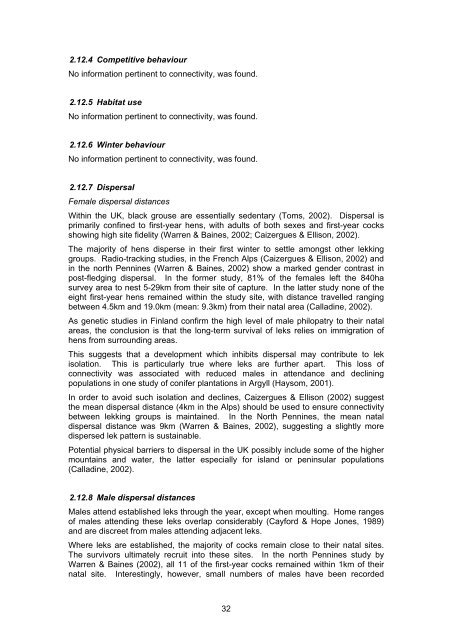Literature review to assess bird species connectivity to Special ...
Literature review to assess bird species connectivity to Special ...
Literature review to assess bird species connectivity to Special ...
Create successful ePaper yourself
Turn your PDF publications into a flip-book with our unique Google optimized e-Paper software.
2.12.4 Competitive behaviour<br />
No information pertinent <strong>to</strong> <strong>connectivity</strong>, was found.<br />
2.12.5 Habitat use<br />
No information pertinent <strong>to</strong> <strong>connectivity</strong>, was found.<br />
2.12.6 Winter behaviour<br />
No information pertinent <strong>to</strong> <strong>connectivity</strong>, was found.<br />
2.12.7 Dispersal<br />
Female dispersal distances<br />
Within the UK, black grouse are essentially sedentary (Toms, 2002). Dispersal is<br />
primarily confined <strong>to</strong> first-year hens, with adults of both sexes and first-year cocks<br />
showing high site fidelity (Warren & Baines, 2002; Caizergues & Ellison, 2002).<br />
The majority of hens disperse in their first winter <strong>to</strong> settle amongst other lekking<br />
groups. Radio-tracking studies, in the French Alps (Caizergues & Ellison, 2002) and<br />
in the north Pennines (Warren & Baines, 2002) show a marked gender contrast in<br />
post-fledging dispersal. In the former study, 81% of the females left the 840ha<br />
survey area <strong>to</strong> nest 5-29km from their site of capture. In the latter study none of the<br />
eight first-year hens remained within the study site, with distance travelled ranging<br />
between 4.5km and 19.0km (mean: 9.3km) from their natal area (Calladine, 2002).<br />
As genetic studies in Finland confirm the high level of male philopatry <strong>to</strong> their natal<br />
areas, the conclusion is that the long-term survival of leks relies on immigration of<br />
hens from surrounding areas.<br />
This suggests that a development which inhibits dispersal may contribute <strong>to</strong> lek<br />
isolation. This is particularly true where leks are further apart. This loss of<br />
<strong>connectivity</strong> was associated with reduced males in attendance and declining<br />
populations in one study of conifer plantations in Argyll (Haysom, 2001).<br />
In order <strong>to</strong> avoid such isolation and declines, Caizergues & Ellison (2002) suggest<br />
the mean dispersal distance (4km in the Alps) should be used <strong>to</strong> ensure <strong>connectivity</strong><br />
between lekking groups is maintained. In the North Pennines, the mean natal<br />
dispersal distance was 9km (Warren & Baines, 2002), suggesting a slightly more<br />
dispersed lek pattern is sustainable.<br />
Potential physical barriers <strong>to</strong> dispersal in the UK possibly include some of the higher<br />
mountains and water, the latter especially for island or peninsular populations<br />
(Calladine, 2002).<br />
2.12.8 Male dispersal distances<br />
Males attend established leks through the year, except when moulting. Home ranges<br />
of males attending these leks overlap considerably (Cayford & Hope Jones, 1989)<br />
and are discreet from males attending adjacent leks.<br />
Where leks are established, the majority of cocks remain close <strong>to</strong> their natal sites.<br />
The survivors ultimately recruit in<strong>to</strong> these sites. In the north Pennines study by<br />
Warren & Baines (2002), all 11 of the first-year cocks remained within 1km of their<br />
natal site. Interestingly, however, small numbers of males have been recorded<br />
32

















